 |
| Nikon D5, Nikon 85mm ƒ/1.8G, ISO 100, ƒ/1.8, 1/1250 |
To accomplish this I used a flash. Now the other thing that I had to do is figure out how to shoot with a flash at ƒ/1.8 outside in the sunlight. This is where High Speed Shutter Sync does the trick. This is when you can take a photo using a flash at any shutter speed and are not locked into the sync speed of 1/250.
I always start with the off camera flash 45º to the left or right of the subject. If their body is facing left then that is the side the light will be placed.
The light is generally 45º above their head. I look to see if the flash causes a shadow that hits their lips. If it does I then lower the light till the shadow is just off the lips of the person. This can also be controlled by lowering of raising the subject's chin. So you have to be aware of light placement throughout the photo shoot as you most likely will have them move their head around.
This is my setup. I have an Alienbees B1600 with a white umbrella that I am shooting through. To sync at the High Shutter Speeds I am using the Pocketwizard TT5 with the AC9 that plugs into the back of the Alienbees using a phone cord connection.
Now with the AC3 on top of the Pocketwizard Mini TT1 you can control the power of the Alienbees from your camera wirelessly. I use the M setting on the AC3
Here is the chart of how that would work:
- +3 = Full Power
- +2 = 1/2 Power
- +1 = 1/4 Power
- 0 = 1/8 Power
- -1 = 1/16 Power
- -2 = 1/32 Power
- -3 = 1/32 Power
You also have the 1/3 increments also to use in between.
 |
| from an earlier shoot. I used only one in the photos at the top |
So here is the basic setup I was using. Here is the list of gear:
- 1 - Alienbee B1600s
- 1 - Vagabond Mini
- 1 - Cowboystudio 7’ 4 Section Portable Adjustable Stand
- 1 - Westcott 2001 43” Optical White Satin Collapsible Umbrella
- 1 - Pocketwizard AC9
- 1 - Pocketwizard TT5
- 1 - Pocketwizard Mini TT1
- 1 - Pocketwizard AC3
- Nikon D5
- Nikon 85mm ƒ/1.8G
I pack the lighting gear all into this Seahorse SE-920 with padded dividers. This is a really super basic kit that I can fly with to jobs where I need something a little more powerful and now capable of still shooting at ƒ/1.8 to get that great BOKEH.
 |
| Nikon D5, Nikon 85mm ƒ/1.8G, ISO 100, ƒ/1.8, 1/4000 |
 |
| Nikon D5, Nikon 85mm ƒ/1.8G, ISO 100, ƒ/7.1, 1/320 |
Here is another example where I needed to change the ƒ-stop.
 |
| Nikon D5, Nikon 85mm ƒ/1.8G, ISO 100, ƒ/1.8, 1/2000 |
 |
| Nikon D5, Nikon 85mm ƒ/1.8G, ISO 100, ƒ/6.3, 1/250 |
Why I chose the Alienbees kit over the Profoto Monolights
Price alone would be enough to make you wonder why you are spending so much more on the Profoto system.
$57.68 on Amazon
Manfrotto 5001B Nano Black Light Stand - 6.2' (1.9m)
I chose this light stand because of how small it folds up [19.3" (49cm)] for easy travel through airports.
$16.23 on Amazon
CowboyStudio 43-Inch Black and White Umbrella for Photography and Video Lighting Reflective
$418 on Amazon
PocketWizard MiniTT1 Radio Transmitter, FlexTT5 Transceiver and AC3 Zone Controller Bundle - Nikon
The AC3 helps you control the flash power from the camera and attaches to the Mini TT1 on the camera.
$54 on Amazon
PocketWizard AC9 AlienBees Adapter Power Control for Nikon
Plugs into Alienbees and onto the TT5
$359.95 from Alienbees
AlienBees™ B1600 Flash Unit
Total cost on my system for one flash $905.86. Just the Profoto B1 flash without a lightstand and umbrella runs $2,095.00.
$2,095.00 from B&H
Profoto B1 500 AirTTL Battery-Powered Flash
When you put together a kit of 3 or 4 lights you can see your money costs really go up with the Profoto system.
The Profoto gives you one thing that the system I designed doesn't give to you and that is TTL. As a general rule when working with studio strobes once you put them in place and take your first photo to check for exposure your lights generally don't move.
Here is the main reason I hate TTL–it is unpredictable. Sure I must take a reading then set my lights without TTL, but every time I take a shot the exposure is not consistent. With TTL just a slight movement with your camera, the model or something in the background will impact your meter and tell the camera and flashes to make an adjustment.











































